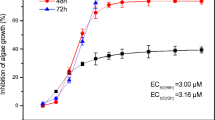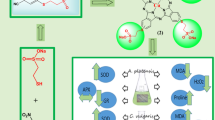Abstract
In this study, we evaluated the role of 2,2′-bipyridine-5,5′-dicarboxylic acid (Bpy-COOH) in protecting Chlorella vulgaris from the oxidative stress and toxicity induced by Cu(II). Both in vivo and in vitro tests were performed. Different addition orders of Bpy-COOH and Cu(II) were tried in the former, whereas different Bpy-COOH concentrations were used in both experiments. The in vivo experiments showed that the production of reactive oxygen species in C. pyrenoidosa treated by the addition of Bpy-COOH and Cu(II) in three orders were all significantly less than that in cases treated with only Cu(II). In vitro tests indicated that peroxidase-like complexes could be formed between Bpy-COOH and Cu(II). Based on these results, it could be concluded that the use of Bpy-COOH could significantly decrease Cu(II) toxicity to algal cells by forming peroxidase-like complexes.







Similar content being viewed by others
References
Amuda OS, Giwa AA, Bello IA (2007) Removal of heavy metal from industrial wastewater using modified activated coconut shell carbon. Biochem Eng J 36:174–181
Bai DR, Baumgartner T (2010) Synthesis and photophysical properties of bipyridine-extended dithienophosphole chromophores for transition metal complexation. Organometallics 29:3289–3297
Chen H, Chen J, Guo YN, Wen YZ, Liu J, Liu WP (2012) Evaluation of the role of the glutathione redox cycle in Cu(II) toxicity to green algae by a chiral perturbation approach. Aquat Toxicol 15:120–121
Chen H, Sheng XL, Wen YZ, Zhang LJ, Bao HL, Lin LN et al (2013) New insights into the effect of the herbicide imazethapyr on Cu(II) ecotoxicity to the aquatic unicellular alga Scenedesmus obliquus. Aquat Toxicol 140–141:407–417
Chong KH, Volesky B (1995) Description of two metal biosorption equilibria by Langmuir-type models. Biotechnol Bioeng 47:451–460
Cid A, Herrero C, Torres E, Abalde J (1995) Copper toxicity on the marine microalga Phaeodactylum tricornutum: effects on photosynthesis and related parameters. Aquat Toxicol 31:165–174
Gyulkhandanyan AV, Feeney CJ, Pennefather PS (2003) Modulation of mitochondrial membrane potential and reactive oxygen species production by copper in astrocytes. J Neurochem 87:448–460
Halliwell B, Gutteridge JMC (1999) Free radicals in biology and medicine. Oxford University Press, Oxford
Katsumata H, Kaneco S, Inomata K, Itoh K, Funasaka K, Masuyama K et al (2003) Removal of heavy metals in rinsing wastewater from plating factory by adsorption with economical viable materials. J Environ Manag 69:187–191
Kiran I, Akar T, Tunali S (2005) Biosorption of Pb(II) and Cu(II) from aqueous solutions by pretreated biomass of Neurosporacrassa. Process Biochem 40:3550–3558
Knauert S, Knauer K (2008) The role of reactive oxygen species in copper toxicity to two freshwater green algae. J Phycol 44:311–319
Manevich Y, Held KD, Biaglow JE (1997) Coumarin-3-carboxylicacid as a detector for hydroxyl radicals generated chemically and by gamma radiation. Radiat Res 148:580–591
Maurya RC, Patel P, Rajput S (2003) Synthesis and characterization of mixed-ligand complexes of Cu(II), Ni(II), Co(II), Zn(II), Sm(III), and U(VI)O2, with a schiff base derived from the sulfa drug sulfamerazine and 2,2′-bipyridine. Synth React Inorg Metal Org Chem 33:801–816
Mohanty JG, Jaffe JS, Schulman ES, Raible DG (1997) A highly sensitive fluorescent microassay of H2O2 release from activated human leukocytes using a dihydroxyphenoxazine derivative. J Immunol Methods 202:133–141
Morrison GMP, Florence TM (1989) Comparison of physicochemical speciation procedures with metal toxicity to Chlorella pyrenoidosa. Copper complexation capacity. Electroamlyski 1:107–112
Nasernejad B, Katsumata H, Kaneco S, Inomata K, Itoh K, Funasaka K et al (2005) Comparison for biosorption modeling of heavy metals (Cr(III), Cu (II), Zn (II)) adsorption from wastewater by carrot residues. Process Biochem 40:1319–1322
Natasha MF, Jennifer LS, Scott JM, Richard PL (2000) pH-dependent toxicity of copper and uranium to a tropical freshwater alga (Chlorella sp.). Aquat Toxicol 48:275–289
Oswald WJ, Lee EW, Adan B, Yao KH (1978) New wastewater treatment method yields a harvest of saleable algae. WHO Chronicle 32:348–350
Pavasant P (2006) Biosorption of Cu +2 , Cd +2 , Pb2 +, and Zn +2 using dried marine green macroalga Caulerpa lentillifera. Bioresour Technol 97:2321–2329
Pinto E (2003) Heavy metal-induced oxidative stress in algae. J Phycol 39:1008–1018
Razinger J, Razinger J, Dermastia M, Drinovec L, Drobne D, Zrimec A et al (2007) Antioxidative responses of duckweed (Lemna minor L.) to short-term copper exposure. Environ Sci Pollut Res 14:194–201
Schiewer S, Volesky B (1995) Modeling of the proton-metal ion exchange in biosorption. Environ Sci Technol 29:3049–3058
Schützendübel A, Polle A (2002) Plant responses to abiotic stresses: heavy metal-induced oxidative stress and protection by mycorrhization. J Exp Bot 53:1351–1365
Shen CS, Chen H, Wu SS, Wen YZ, Li LN, Jiang Z et al (2013) Highly efficient detoxification of Cr(VI) by chitosan-Fe(III) complex: process and mechanism studies. J Hazard Mater 244–245:689–697
Siaut M, Cuiné S, Cagnon C, Fessler B, Nguyen M, Carrier P et al (2001) Oil accumulation in the model green alga Chlamydomonas reinhardtii: characterization, variability between common laboratory strains and relationship with starch reserves. BMC Biotechnol 11:7
Sigel H (1969) Catalase and peroxidase activity of Cu +2 complexes. Angew Chem 8:167–177
Sigel H, Flierl C, Griesser R (1968) On the kinetics and mechanism of the decomposition of hydrogen peroxide, catalyzes by the Cu +2 -2,2′-bipyridyl complex. J Am Chem Soc 91:1061–1064
Siripornadulsil S, Siripornadulsil S, Traina S, Verma DP, Sayre RT (2002) Molecular mechanisms of proline-mediated tolerance to toxic heavy metals in transgenic microalgae. Plant Cell 14:284–2837
Skowroński T (1986) Sorption of cadmium on green microalga Stichococcus bacillaris. Chemosphere 15:69–76
Stauber JL, Florence TM (1987) Mechanism of toxicity of ionic copper and copper complexes to algae. Mar Biol 94:511–519
Stohs SJ, Bagchi D (1995) Oxidative mechanisms in the toxicity of metal ions. Free Radic Biol Med 18:321–336
Szivák I, Behra R, Laura Sigg (2009) Metal-induced reactive oxygen species production in Chlamydonas reinhardtii (Chlorophyceae). J Phycol 45:427–435
Terry PA, Stone W (2002) Biosorption of cadmium and copper contaminated water by Scenedesmus abundans. Chemosphere 47:249–255
Tsuji N, Hirayanagi N, Okada M, Miyasaka H, Hirata K, Zenk MH et al (2002) Enhancement of tolerance to heavy metals and oxidative stress in Dunaliella tertiolecta by Zn-induced phytochelatin synthesis. Biochem Biophys Res 293:653–659
Veglio F, Beolchini F (1997) Removal of metals by biosorption: a review. Hydrometallurgy 44:301–316
Wang L, Min M, Li Y, Chen P, Chen Y, Liu Y et al (2010) Cultivation of green algae Chlorella sp. in different wastewaters from municipal wastewater-treatment plant. Appl Biochem Biotechnol 162:1174–1186
Wen YZ, Yuan YL, Chen H, Xu DM, Lin KD, Liu WP (2010) Effect of chitosan on the enantioselective bioavailability of the herbicide dichlorprop to Chlorella pyrenoidosa. Environ Sci Technol 44:4981–4987
Wen YZ, Chen H, Shen CS, Zhao MR, Liu WP (2011) Enantioselectivity tuning of chiral herbicide dichlorprop by copper: roles of reactive oxygen species. Environ Sci Technol 45:4778–4784
Acknowledgments
This study was supported by the National Natural Science Foundation of China (Grant No. 21377111), the Zhejiang Provincial Natural Science Foundation of China (Grant No. LY12B07006), Shanghai Municipal Natural Science Foundation (Grant No. 13ZR1447800), and the Knowledge Innovation Program of Chinese Academy of Sciences.
Author information
Authors and Affiliations
Corresponding author
Rights and permissions
About this article
Cite this article
Wen, Y., Sheng, X., Song, S. et al. Protection Against Cu(II)-Induced Oxidative Stress and Toxicity to Chlorella vulgaris by 2,2′-Bipyridine-5,5′-dicarboxylic Acid. Arch Environ Contam Toxicol 66, 400–406 (2014). https://doi.org/10.1007/s00244-013-9977-2
Received:
Accepted:
Published:
Issue Date:
DOI: https://doi.org/10.1007/s00244-013-9977-2




